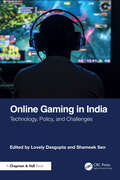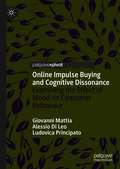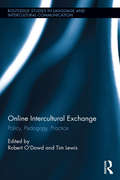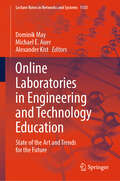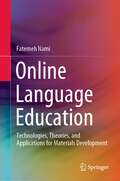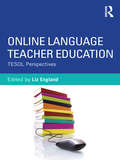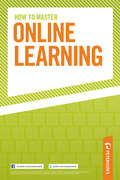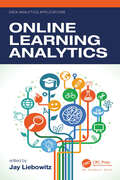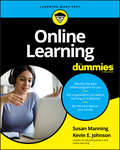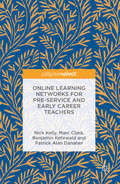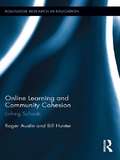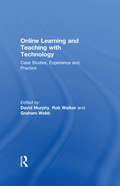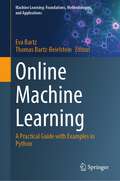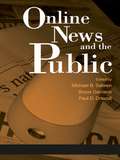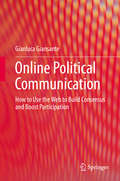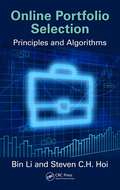- Table View
- List View
Online Gaming in India: Technology, Policy, and Challenges
by Lovely Dasgupta Shameek SenThis book offers a comprehensive overview from diverse perspectives of online gaming technology, policy, and experiments to understand and review the Indian approach. It starts with the technological viewpoint on the governance and regulation of online gaming and includes the Indian experiment in governing and regulating it. The book brings a nuanced approach related to the perspectives of various stakeholders, the players, the developers, the gamers, the regulators, the law enforcement agencies, the industry and most importantly, the consumers, who are also the intended audience of the work. Present a holistic view of the online gaming industry from technical, legal and policymaking perspectives Offers critical technical highlights include Online transactions, online games ecosystem, online games varied platforms, web3, metaverse, AI and Fantasy Games Includes a comparative analysis to evaluate better the laws, rules, and regulations and the governance of online gaming in India Encapsulates the Indian experience in intervening and streamlining the online gaming industry The book is for Professionals and scholars in the fields of Online Gaming in computer science, Law, and other related discipline. It also serves as a textbook for students for Online Gaming courses.
Online Harassment (Human–Computer Interaction Series)
by Jennifer GolbeckOnline Harassment is one of the most serious problems in social media. To address it requires understanding the forms harassment takes, how it impacts the targets, who harasses, and how technology that stands between users and social media can stop harassers and protect users. The field of Human-Computer Interaction provides a unique set of tools to address this challenge. This book brings together experts in theory, socio-technical systems, network analysis, text analysis, and machine learning to present a broad set of analyses and applications that improve our understanding of the harassment problem and how to address it. This book tackles the problem of harassment by addressing it in three major domains. First, chapters explore how harassment manifests, including extensive analysis of the Gamer Gate incident, stylistic features of different types of harassment, how gender differences affect misogynistic harassment. Then, we look at the results of harassment, including how it drives people offline and the impacts it has on targets. Finally, we address techniques for mitigating harassment, both through automated detection and filtering and interface options that users control. Together, many branches of HCI come together to provide a comprehensive look at the phenomenon of online harassment and to advance the field toward effective human-oriented solutions.
Online Harms and Cybertrauma: Legal and Harmful Issues with Children and Young People
by Catherine KnibbsThis vital, sensitive guide explains the serious issues children face online and how they are impacted by them on a developmental, neurological, social, mental health and wellbeing level. Covering technologies used by children aged two through to adulthood, it offers parents and professionals clear, evidence-based information about online harms and their effects and what they can do to support their child should they see, hear or bear witness to these events online. Catherine Knibbs, specialist advisor in the field, explains the issues involved when using online platforms and devices in family, social and educational settings. Examined in as non-traumatising a way as possible, the book covers key topics including cyberbullying; cyberstalking; pornography; online grooming; sexting; live streaming; vigilantism; suicide and self-harm; trolling and e-harassment; bantz, doxing and social media hacking; dares, trends and life-threatening activities; information and misinformation; and psychological games. It also explores the complex overlap of offline and online worlds in children and young people’s lives. Offering guidance and proactive and reactive strategies based in neuroscience and child development, it reveals how e-safety is not one size fits all and must consider individual children’s and families’ vulnerabilities. Online Harms and Cybertrauma will equip professionals and parents with the knowledge to support their work and direct conversations about the online harms that children and young people face. It is essential reading for those training and working with children in psychological, educational and social work contexts, as well as parents, policy makers and those involved in development of online technologies.
Online Hate Speech: Analysis, Detection, and Mitigation (Synthesis Lectures on Human Language Technologies)
by Animesh Mukherjee Punyajoy Saha Mithun DasThis book informs readers on how to understand, detect, and mitigate hate speech in online social media. The authors first cover the definition of hate speech and how its prevalence can be measured on online social media platforms using text and graph-based methods. The book then describes the process of detecting hate speech and presents a comprehensive account of the AI models that are currently being used. Further, the authors discuss the associated challenges that must be overcome while using these models. The book concludes with an overview of the mitigation techniques for hate speech, including blocking or suspension of the accounts (hard technique) and counterspeech (soft technique), and a discussion of the effects of these techniques on social media platforms.
Online Impulse Buying and Cognitive Dissonance: Examining the Effect of Mood on Consumer Behaviour
by Ludovica Principato Giovanni Mattia Alessio Di LeoConsumers’ beliefs and attitudes towards online sales significantly influence buying behavior on the internet. However, the impact of these thoughts and beliefs on the decision to make an online purchase is not direct. It can be moderated by the emotions experienced while browsing an e-commerce website. Impulse buying in particular is influenced by a number of factors, for example how stimulating the e-shopping platform is, and how easy it is to click on the cart a certain product, for instance a smartphone. But what happens after an online impulse buy is made? Often the customer can regret the purchase and in the throes of anxiety, look for reasons to justify the choices made. Consumer behaviour scholars and pyschologists call this phenomenon cognitive dissonance, and certain individuals are more sensitive than others in developing this than others.This book offers a deep investigation around online impulse buying and subsequent cognitive dissonance. Specifically, the authors present a research case study of a group of millenials who are shopping for smartphones to study whether an initial positive state can reduce the onset of cognitive dissonance in consumers. Based on substantial research and a sample of 212 impulsive millennial buyers, the book provides a comprehensive, but simple and synthetic framework of impulse buying, cognitive dissonance and positive affect state, highlighting their relationships.
Online Intercultural Exchange: Policy, Pedagogy, Practice (Routledge Studies in Language and Intercultural Communication #15)
by Tim Lewis Robert O'DowdThis volume provides a state of the art overview of Online Intercultural Exchange (OIE) in university education and demonstrates how educators can use OIE to address current challenges in university contexts such as internationalisation, virtual mobility and intercultural foreign language education. Since the 1990s, educators have been using virtual interaction to bring their classes into contact with geographically distant partner classes to create opportunities for authentic communication, meaningful collaboration and first-hand experience of working and learning with partners from other cultural backgrounds. Online exchange projects of this nature can contribute to the development of learner autonomy, linguistic accuracy, intercultural awareness, intercultural skills and electronic literacies. Online Intercultural Exchange has now reached a stage where it is moving beyond individual classroom initiatives and is assuming a role as a major tool for internationalization, intercultural development and virtual mobility in universities around the globe. This volume reports qualitative and quantitative findings on the impact of OIE on universities in Europe and elsewhere and offers comprehensive guidance on using OIE at both pedagogical and technological levels. It provides theoretically-informed accounts of Online Intercultural Exchanges which will relevant to researchers in Computer Assisted Language Learning, Computer-Mediated Communication, or Virtual Education. Finally, contributors offer a collection of practitioner-authored and practically-oriented case studies for the benefit of teachers of foreign languages or in other subject areas who wish to engage in developing the digital literacy and intercultural competences of their learners.
Online Intermediaries for Co-Creation
by Christoph W. KünneThis book investigates the powerful role of online intermediaries, which connect companies with their end customers, to facilitate joint product innovation. Especially in the healthcare context, such intermediaries deploy interactive online platforms to foster co-creation between engaged healthcare consumers and innovation-seeking healthcare companies. In three empirical studies, this book outlines the key characteristics of online intermediaries in healthcare, their distinct strategies, and the remaining challenges in the field. Readers will also be introduced to the stages companies go through in adopting such co-created solutions. As such, the work appeals for both its academic scope and practical reach.
Online Investing Hacks: 100 Industrial-Strength Tips & Tools
by Bonnie BiaforeFor the geek who's an investor, and the investor who's a geek, we present Online Investing Hacks, 100 industrial-strength, bleeding edge tips, tools and techniques for analyzing and managing online portfolios.Individual investors have become more computer-literate and technology-dependent than ever before. Whether you're looking for suitable investments, studying alternatives, or managing your portfolios, you need data. The Internet can be a goldmine of financial data and research, but today's online investors also use spreadsheets, databases, and financial applications to select, study and manage investments. If your proficiency has grown to the point where you crave industrial-strength tips and tools to turbo-charge your efforts, this is the book for you.Online Investing Hacks covers:Screening InvestmentsCollecting DataFundamental AnalysisTechnical AnalysisExecuting TradesInvesting in Mutual FundsPortfolio ManagementUpdating Stock DataFinancial PlanningOther books for managing online investing are either out of date, are for beginners and don't go beyond the most basic advice, or are so dull and boring they squeeze that last bit of fun out of the topic. Online Investing Hacks is for the customer who wants to know the latest techniques, to go beyond the basics, who gets jazzed by cool online tools and services, and who actually wants to have a bit of fun while trying to strike it rich (or at least not lose their shirt).
Online Laboratories in Engineering and Technology Education: State of the Art and Trends for the Future (Lecture Notes in Networks and Systems #1135)
by Michael E. Auer Dominik May Alexander KistThis comprehensive book, divided into seven sections, showcases groundbreaking research findings that blend new experiences from the COVID-19 pandemic with long-term research on online laboratories and virtual experimentation. Providing an adequate learning experience in the laboratory has long been a major challenge in science, engineering, and technology education. Recent years have further revealed the complexities of offering distance or remotely accessible educational settings, particularly for laboratory-based courses. In response, many academic institutions have innovated by transitioning their laboratory classes into online laboratories or providing laboratory kits for at-home use. This unprecedented situation has sparked numerous new developments, approaches, and activities, revolutionizing the field. With contributions from leading researchers and practitioners across diverse disciplines, this book delves into current trends, addresses critical challenges, and uncovers future opportunities for laboratory-based education in the context of online learning. Whether readers are educators seeking innovative teaching strategies, researchers exploring the latest advancements, or academic leaders looking to enhance remote learning experiences, this book provides valuable insights and practical solutions. It explores how online laboratories are transforming education and discovers the potential they hold for the future.
Online Language Education: Technologies, Theories, and Applications for Materials Development
by Fatemeh NamiThis book addresses the gap between Computer-Assisted Language Learning (CALL) materials development and its theoretical considerations by offering a comprehensive look into theory, practice, and research on materials development and content authoring for language instruction/practice, drawing on the author’s personal experiences along with previous empirical/theoretical research in CALL materials development, content authoring, language teacher education, and e-learning. The book features four sections. In addition to highlighting related theoretical underpinnings, key concepts, linguistic-didactic functionalities and interaction scenarios in materials development, the volume will address the practical issues and considerations not only in the design, development, integration, and evaluation of the technology-enhanced materials development for language instruction but also the protection, usability, and access in authored and/or co-authored content. Furthermore, previous research findings and foci are addressed to highlight the research gaps and pedagogical implications for materials developers, policy makers, and language teachers. The book can help teachers, educators, and researchers overcome the aforementioned problem by providing a step-by-step guideline on how to effectively integrate technology and design and develop instructional materials for online language instruction and practice.
Online Language Teacher Education: TESOL Perspectives
by Liz EnglandMore and more, ESL/EFL teachers are required by their employers to obtain a Master’s degree in TESOL. Thousands of ESL/EFL teachers are acquiring professional skills and knowledge through online and distance education instructional models. Filling a growing need and making an important contribution, this book is a forerunner in addressing some of the issues and problems for online distance learning and instructional delivery in TESOL and applied linguistics departments in universities around the world. Carefully addressing the complexity of the field, this volume includes primary research and case studies of programs where a variety of online distance models are used. Structured in a logical sequence, the readable and accessible content represents the collected expertise of leading language teacher educators. Each chapter brings the reader a better understanding and ability to apply knowledge about online distance TESOL education.
Online Learning
by Peterson'sHow to Master Online Learning provides information about online degree programs, online certifications, and continuing education; advice on paying for online classes, software, and textbooks; and expert strategies for online learning success. Online learning continues to grow and evolve as the most popular form of distance learning. For the most comprehensive online learning guidance, including tips on making the most of your online learning experience, choose Peterson's How to Master Online Learning.
Online Learning Analytics (Data Analytics Applications)
by Jay Liebowitz"In our increasingly digitally enabled education world, analytics used ethically, strategically, and with care holds the potential to help more and more diverse students be more successful on higher education journeys than ever before. Jay Liebowitz and a cadre of the fields best ‘good trouble’ makers in this space help shine a light on the possibilities, potential challenges, and the power of learning together in this work." —Mark David Milliron, Ph.D., Senior Vice President and Executive Dean of the Teachers College, Western Governors University Due to the COVID-19 pandemic and its aftereffects, we have begun to enter the "new normal" of education. Instead of online learning being an "added feature" of K–12 schools and universities worldwide, it will be incorporated as an essential feature in education. There are many questions and concerns from parents, students, teachers, professors, administrators, staff, accrediting bodies, and others regarding the quality of virtual learning and its impact on student learning outcomes. Online Learning Analytics is conceived on trying to answer the questions of those who may be skeptical about online learning. Through better understanding and applying learning analytics, we can assess how successful learning and student/faculty engagement, as examples, can contribute towards producing the educational outcomes needed to advance student learning for future generations. Learning analytics has proven to be successful in many areas, such as the impact of using learning analytics in asynchronous online discussions in higher education. To prepare for a future where online learning plays a major role, this book examines: Data insights for improving curriculum design, teaching practice, and learning Scaling up learning analytics in an evidence-informed way The role of trust in online learning. Online learning faces very real philosophical and operational challenges. This book addresses areas of concern about the future of education and learning. It also energizes the field of learning analytics by presenting research on a range of topics that is broad and recognizes the humanness and depth of educating and learning.
Online Learning For Dummies
by Susan Manning Kevin E. JohnsonIdentify the best online program for you Get organized to succeed at learning at a distance Be the best learner you can be Get your best education online Whether you're a college student, adult learner, or professional in continuing education, some—and sometimes all—of your learning will happen in a virtual classroom. This book is your friendly guide to the fast-growing possibilities of this world, from choosing the right course and mastering the software to polishing up your online communication and study skills. Whatever you want from your study experience—school success, professional development, or just pursuing your passion—this is your road map to online educational success! Inside... Find the right course for you Prep successfully for classes Manage time online Apply for study funding Transfer credits Master the software Get the right hardware Develop online etiquette
Online Learning Networks for Pre-Service and Early Career Teachers
by Nick Kelly Marc Clarà Benjamin Kehrwald Patrick Alan Alan DanaherHow can we improve support for teachers as they negotiate the pathways into the profession? This books highlights how strong networks of connections with other teachers and with resources have been shown to make a big difference. Online learning networks are one way to help pre-service and early career teachers to foster these connections and the greater community of teachers has an interest in helping new teachers to enter the profession. New technologies have allowed teachers to be connected anywhere, anytime; this book discusses principles for the design and implementation of learning networks that can use this connectivity to improve support for beginning teachers. It addresses foundational principles of types of teacher communities (online and offline), types of knowledge relevant to beginning teachers, the idea of presence within a network and methodologies for studying and nurturing communities of teachers, providing recent examples of each.
Online Learning and Community Cohesion: Linking Schools (Routledge Research in Education #98)
by Roger Austin Bill HunterNational governments and multi-national institutions are spending unprecedented amounts of money on ICT on improving the overall quality of school learning, and schools are increasingly expected to prepare young people for a global economy in which inter-cultural understanding will be a priority. This book explores and analyzes the ways ICT has been used to promote citizenship and community cohesion in projects that link together schools in different parts of the world. It examines the theoretical framework behind such work and shows the impact of initiatives in the Middle East, Canada, the USA, England, Northern Ireland, the Republic of Ireland and elsewhere in the European Union. This is a critical examination of the technologies that have been deployed, the professional development that has been provided and an evaluation of what constitutes good practice, particularly in terms of what collaborative learning really means for young people. Many of these initiatives have enabled young people to develop more positive relations with culturally and religiously different neighbours, but this work has just begun. Continuing international tensions over matters of identity and faith require that we better understand the political context for such work so that we might shape future directions more deliberately and more clearly.
Online Learning and Teaching with Technology: Case Studies, Experience and Practice
by Rob Walker David Murphy Graham WebbIn the 21st century technology has become an essential part of teaching and learning. This manual provides practical advice on teaching in a wide range of technologies, including the internet and multimedia packages. Using case studies to illustrate the key concepts, this book aims to promote student learning and understanding, and show educators how to use technology to motivate learners and encourage productive interaction.
Online Machine Learning: A Practical Guide with Examples in Python (Machine Learning: Foundations, Methodologies, and Applications)
by Thomas Bartz-Beielstein Eva BartzThis book deals with the exciting, seminal topic of Online Machine Learning (OML). The content is divided into three parts: the first part looks in detail at the theoretical foundations of OML, comparing it to Batch Machine Learning (BML) and discussing what criteria should be developed for a meaningful comparison. The second part provides practical considerations, and the third part substantiates them with concrete practical applications. The book is equally suitable as a reference manual for experts dealing with OML, as a textbook for beginners who want to deal with OML, and as a scientific publication for scientists dealing with OML since it reflects the latest state of research. But it can also serve as quasi OML consulting since decision-makers and practitioners can use the explanations to tailor OML to their needs and use it for their application and ask whether the benefits of OML might outweigh the costs. OML will soon become practical; it is worthwhile to get involved with it now. This book already presents some tools that will facilitate the practice of OML in the future. A promising breakthrough is expected because practice shows that due to the large amounts of data that accumulate, the previous BML is no longer sufficient. OML is the solution to evaluate and process data streams in real-time and deliver results that are relevant for practice.
Online Machine Learning: Eine praxisorientierte Einführung
by Thomas Bartz-Beielstein Eva BartzDieses Buch beschreibt Theorie und Anwendungen aus dem Bereich des Online Maschine Learnings (OML), wobei der Fokus auf Verfahren des überwachten Lernens liegt. Es werden Verfahren zur Drifterkennung und -behandlung beschrieben. Verfahren zur nachträglichen Aktualisierung der Modelle sowie Methoden zur Modellbewertung werden dargestellt. Besondere Anforderungen aus der amtlichen Statistik (unbalancierte Daten, Interpretierbarkeit, etc.) werden berücksichtigt. Aktuelle und mögliche Anwendungen werden aufgelistet. Ein Überblick über die verfügbaren Software-Tools wird gegeben. Anhand von zwei Studien (“simulierten Anwendungen”) werden Vor- und Nachteile des OML-Einsatz in der Praxis experimentell analysiert.
Online Marketing
by Ralf T. KreutzerAlle Grundlagen des Online-Marketings vereint in einem BuchWenn Sie sich für Online-Marketing interessieren, ist dieses Buch genau richtig für Sie. Es führt Sie behutsam in die Grundlagen der Online-Werbung ein und erläutert verschiedene Gebiete dieses umfangreichen Themenkomplexes. Neben den unterschiedlichen Erfolgsfaktoren und Zielsetzungen im Online-Marketing stellt der Autor auch zahlreiche Instrumente zur Erfolgsmessung vor. Mit diesem umfassenden Grundlagenwerk erhalten Sie nicht nur eine Einführung in das Online-Marketing, sondern auch einen detaillierten Einblick in das E-Commerce im Allgemeinen. Die vorliegende zweite Auflage wurde umfassend überarbeitet und um die neuesten Entwicklungen im Online-Marketing ergänzt. Neu sind unter anderem ausführliche Kapitel zu Themen wie E-Mail-, Social-Media- und Suchmaschinenmarketing.Optimale Prüfungsvorbereitung für Marketing-StudentenDer Autor legt großen Wert auf eine nachhaltige Wissensvermittlung, was sich in der didaktische Struktur des Werkes widerspiegelt. Es richtet sich insbesondere an Bachelorstudierende und Nebenfachstudenten des Studiengangs Marketing. Durch übersichtliche Lerneinheiten mit begleitenden Kontrollmodulen können sie das gelernte Wissen prüfen und vertiefen und sich so optimal auf Klausuren vorbereiten.Aber auch Angestellte in Werbeagenturen profitieren von der Expertise des Autors, da er nie den Praxisbezug zum Online-Marketing aus den Augen verliert. Dank vieler Leseempfehlungen können sich Interessierte spielend leicht tiefergehend mit den einzelnen Themen befassen.
Online Marketing Inside Out: Reach New Buyers Using Modern Marketing Techniques
by Brandon Eley Shayne TilleyOnline Marketing Inside Out is an invaluable book for anyone wanting to market products or services online - whether or not marketing is part of your job description. Small-business entrepreneurs and web-site owners will benefit from this information-packed book, as will traditional marketers with little or no experience of online marketing. With so many potential customers online this book will show you how to reach and interact with them through podcasting, blogs, social networks, video, email, and contextual advertising. This book doesn't just cover the basics, it is inspiring reading for anyone looking for new ways to reach new and larger customer bases. You will learn about: The changing face of marketing The new frontier of PR and media Using your web site to generate income Getting the most from the search engine crowd Promote your message through socializing Implementing profitable email marketing campaigns Getting others to sell your products for you Spreading your message through online advertising. Editorial Reviews"Online Marketing Inside Out is a great bridge between what's come before in online marketing and what's coming up and worth checking out. " Chris Brogan"There's everything from social media to affiliate marketing to paid search knowledge there. Please do check it out. If you're hoping to use the Internet to promote your business, this book will come in handy." Jason Falls"Online Marketing Inside Out" is a top-notch resource on the basics of online marketing. It provides a firm foundation from which ecommerce marketers can launch campaigns, and it can serve as a good starting place for more in depth research about any of the topics it covers." Practical E-Commerce"If you've ever wanted to use social media to increase your traffic, set up your own affiliate program, or just explain the various online advertising options to clients, then Online Marketing Inside Out is a great starting point" Freelance Switch"I highly recommend Online Marketing Inside Out as a reference point for people who want to get started with their online marketing efforts and for experienced marketers who might need a solid checklist to compare their existing campaigns against." Cory Huff - Sparkplugging"Online Marketing Inside Out is a great book for those who want a no-hype understanding on the how and why of online marketing" Miles Burke"The book explains that successful marketing involves steps summed up as: attract, engage and transact. However, equally important to executing a successful campaign is understanding the medium, whether it's email or FaceBook or a setting-up an affiliate program. A successful campaign will use that that knowledge and measure the results." yyztech
Online Marketing for Your Craft Business: How to Get Your Handmade Products Discovered, Shared and Sold on the Internet
by Hilary PullenA highly focused guide to using social media and blogging to measurably impact on the sales and brand awareness of your handmade products to actively grow a craft business. Social media and craft marketing expert Hilary Pullen will help you develop a 360 degree strategy for online networking, outlining the resources and time you need to commit. She will take you through how to identify who you want to connect with, where you will connect with them and what type of things you want to share and say to them, all with relevant examples and case studies. You'll see that when properly planned and managed, you will learn to love blogging and social media as a fun tool that can enhance your creativity, and not be a time-wasting chore! Author Hilary Pullen is a digital marketing consultant and writes for ukcraftblog.com which has over 60k monthly page views. Etsy - the world's largest online marketplace for selling crafts - now has more than 30 million members, with over 1 million new members joining each month. "I know what it takes first hand to market your crafts online and Hilary's book is one of the most detailed marketing books out there for creative business owners... If you are looking for a marketing guide to help your craft business thrive, then you need to pick up Hilary's book." --Timothy Adam, Handmadeology
Online News and the Public (Routledge Communication Series)
by Bruce Garrison Michael B. Salwen Paul D. DriscollThis volume offers unique and timely insights on the state of online news, exploring the issues surrounding this convergence of print and electronic platforms, and the public's response to it. It provides an overview of online newspapers, including current trends and legal issues and covering issues of credibility and perceptions by online news users.The heart of the book is formed by empirical studies-mostly social surveys-coming out of the media effects and uses traditions. The chapters are grounded in theoretical frameworks and bring much-needed theory to the study of online news. The frameworks guiding these studies include media credibility, the third-person effect, media displacement, and uses and gratifications. The book ends with a section devoted to research on online news postings.This book is appropriate for scholars, researchers, and students in journalism, mass communication, new media, and related areas, and will be of interest to anyone examining how people use the web as a source for news.
Online Political Communication
by Gianluca GiansanteThis book provides research findings and practical information on online communication strategies in politics. Based on communication research and real-world political-campaign experience, the author examines how to use the Web and social media to create public visibility, build trust and consensus and boost political participation. It offers a useful guide for practitioners working in the political arena, as well as for those managing communication projects in institutions or companies.
Online Portfolio Selection: Principles and Algorithms
by Bin Li Steven Chu HoiWith the aim to sequentially determine optimal allocations across a set of assets, Online Portfolio Selection (OLPS) has significantly reshaped the financial investment landscape. Online Portfolio Selection: Principles and Algorithms supplies a comprehensive survey of existing OLPS principles and presents a collection of innovative strategies that leverage machine learning techniques for financial investment.The book presents four new algorithms based on machine learning techniques that were designed by the authors, as well as a new back-test system they developed for evaluating trading strategy effectiveness. The book uses simulations with real market data to illustrate the trading strategies in action and to provide readers with the confidence to deploy the strategies themselves. The book is presented in five sections that: Introduce OLPS and formulate OLPS as a sequential decision task Present key OLPS principles, including benchmarks, follow the winner, follow the loser, pattern matching, and meta-learning Detail four innovative OLPS algorithms based on cutting-edge machine learning techniques Provide a toolbox for evaluating the OLPS algorithms and present empirical studies comparing the proposed algorithms with the state of the art Investigate possible future directions Complete with a back-test system that uses historical data to evaluate the performance of trading strategies, as well as MATLAB® code for the back-test systems, this book is an ideal resource for graduate students in finance, computer science, and statistics. It is also suitable for researchers and engineers interested in computational investment.Readers are encouraged to visit the authors’ website for updates: http://olps.stevenhoi.org.
